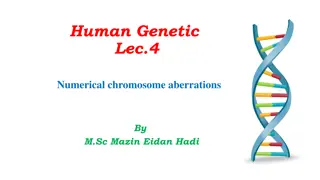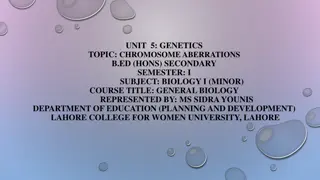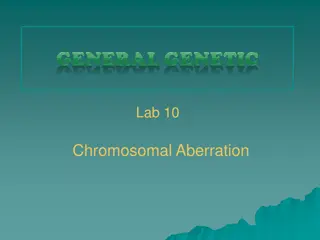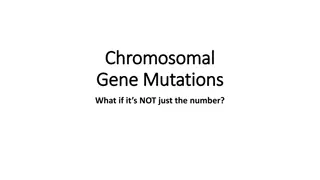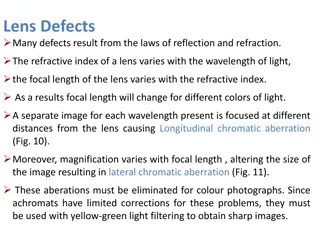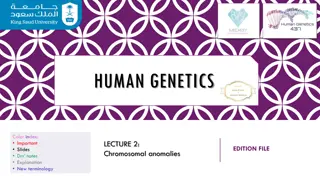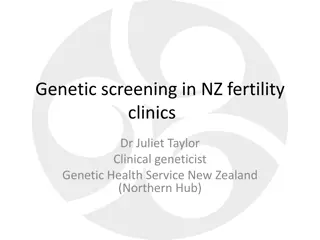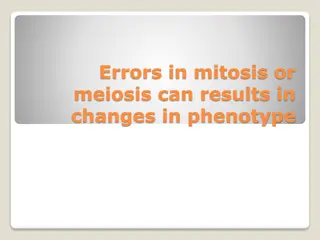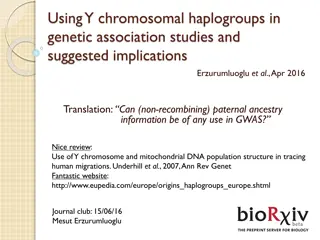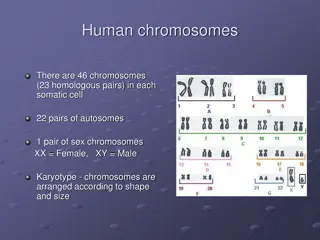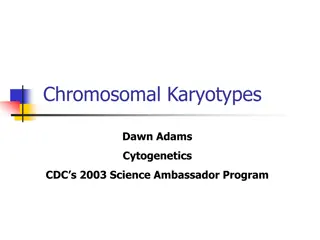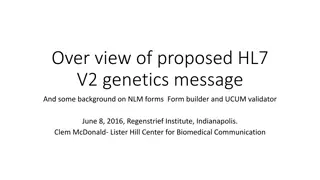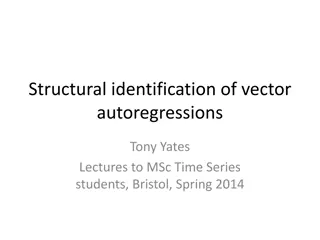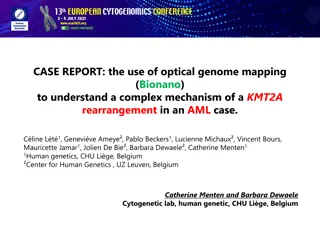Understanding Structural Chromosomal Aberrations and Their Impact on Genetic Information
Chromosomal aberrations involve significant changes in chromosome structure and number, impacting multiple genes. These mutations can be structural or numerical, resulting in alterations such as deletions, duplications, inversions, and translocations. Deletions, for example, involve missing chromosomal segments and can lead to various outcomes depending on the affected genes. Human disorders linked to large chromosomal deletions often manifest in heterozygous individuals. The study of these abnormalities provides insights into genetic variations and their consequences.
Download Presentation

Please find below an Image/Link to download the presentation.
The content on the website is provided AS IS for your information and personal use only. It may not be sold, licensed, or shared on other websites without obtaining consent from the author. Download presentation by click this link. If you encounter any issues during the download, it is possible that the publisher has removed the file from their server.
E N D
Presentation Transcript
Structural Chromosomal Aberrations DR. Neha Antal Assistant Professor Department of Zoology Govt. P.G. College for Women, Gandhinagar, Jammu
Chromosomal aberrations are substantial changes in chromosome structure and number These typically affect more than one gene They are also called chromosomal mutations Chromosomal aberrations or mutation is of two types Structural chromosomal mutation: Changes inn the gene number or gene arrangement Numerical chromosomal mutation: Change in the number of chromosome
Alterations in Chromosome Structure There are two primary ways in which the structure of chromosomes can be altered The total amount of genetic information in the chromosome can change Decrease: Deficiencies/Deletions Increase: Duplications & Insertions The genetic material may remain the same, but is rearranged Inversions Translocations
Alterations in Chromosome Structure Deletion Loss of a chromosomal segment Duplication Repetition of a chromosomal segment Inversion A change in the direction of genetic material along a single chromosome Translocation A segment of one chromosome becomes attached to a non-homologous chromosome Simple translocations One way transfer Reciprocal translocations Two way transfer
DELETION Part of a chromosome is missing Deletions start with chromosomal breaks induced by: Heat or radiation (especially ionizing). Viruses. Chemicals. Transposable elements. Errors in recombination. Deletions do not revert, because the DNA is gone (degraded) Types: Terminal - involve one break Intercalary- involve two breaks
DELETION The effect of a deletion depends on what was deleted. A deletion in one allele of a homozygous wild- type organism may give a normal phenotype While the same deletion in the wild-type allele of a heterozygote would produce a mutant phenotype. Deletion of the centromere results in an acentric chromosome that is lost, usually with serious or lethal consequences.
Human disorders caused by large chromosomal deletions are generally seen in heterozygotes, since homozygotes usually die. The number of gene copies is important. Syndromes result from the loss of several to many genes. Examples of human disorders caused by large chromosomal deletions: Cri-du-chat ( cry of the cat ) syndrome, resulting from deletion of part of the short arm of chromosome 5 Cat like cry, malformation of larynx, moon face, micrognathia, microcephally, low set ears, mental retardation.
Cri du chat Syndrome Cri du chat Syndrome Variation in phenotype Variation in phenotype associated with region deleted associated with region deleted has been observed has been observed regions with genes involved in regions with genes involved in larynx and nervous system larynx and nervous system development development Researchers have identified Researchers have identified Pseudo-dominance: In the presence of deletion, sometimes a recessive allele of the normal homologous chromosome will behave like a dominant allele i.e. it will phenotypically express itself.
Duplication Duplications result from doubling of chromosomal segments Presence of a part of a chromosome in excess of the normal complement
Duplication Tandem duplications are adjacent to each other. Reverse tandem duplications result in genes arranged in the opposite order of the original. Tandem duplication at the end of a chromosome is a terminal tandem duplication
Duplication Displaced duplication duplicated region is not situated adjacent to the original. Transposed duplication duplicated part arrange to a non homologous chromosome
Duplication An example is the Drosophila eye shape allele, Bar, that reduces the number of eye facets, giving the eye a slit-like rather than oval appearance. Cytological examination of chromosomes showed that the Bar allele results from duplication of a small segment (16A) of the X chromosome.
Duplication loops form when chromosomes pair in duplication heterozygotes In prophase I, the duplication loop can assume different configurations that maximize the pairing of related regions
Position Effect Due to change in the position of a gene or a gene group in relation to other genes in a chromosome, phenotype of organism is altered, this effect is called position effect. It also represents a source of genetic variation.
Inversion Rotation of a part of a chromosome or a set of genes by 180 on its own axis.
Inversion The meiotic consequence depends on whether the inversion occurs in a homozygote or a heterozygote. A homozygote will have normal meiosis. The effect in a heterozygote depends on whether crossing-over occurs. If there is no crossing-over, no meiotic problems occur. If crossing-over occurs in the inversion, unequal crossover may produce serious genetic consequences.
Inversion Heterozygous Pericentric Inversion: One normal gamete One gamete with inversion One gamete with a duplication and deletion. One gamete with reciprocal duplication and deletion. Heterozygous Paracentric Inversion: One normal gamete One gamete with inversion Two deletion products Some material lost.
Crossing over in Pericentric Inversion Crossing over in Pericentric Inversion
Crossing over in Paracentric Inversion Crossing over in Paracentric Inversion
In an inversion, the total amount of genetic information stays the same Therefore, the great majority of inversions have no phenotypic consequences In rare cases, inversions can alter the phenotype of an individual Break point effect The breaks leading to the inversion occur in a vital gene Position effect A gene is repositioned in a way that alters its gene expression About 2% of the human population carries inversions that are detectable with a light microscope Most of these individuals are phenotypically normal However, a few produce offspring with genetic abnormalities
Translocation A chromosomal translocation occurs when a segment of one chromosome becomes attached to another. There are two main types of medically important translocations: Reciprocal (balanced) Translocations Robertsonian (unbalanced) Translocations Both types of translocations are capable of causing disease in humans .
Reciprocal Translocations In reciprocal translocations two non-homologous chromosomes exchange genetic material Reciprocal translocations lead to a rearrangement of the genetic material not a change in the total amount Thus, they are also called balanced translocations. .
Robertsonian Translocations In Robertsonian Translocations the transfer of genetic material occurs in only one direction Robertsonian translocations are associated with phenotypic abnormalities or even lethality. Example: Familial Down Syndrome In this condition, the majority of chromosome 21 is attached to chromosome 14. The individual would have three copies of genes found on a large segment of chromosome 21 Therefore, they exhibit the characteristics of Down syndrome .
This translocation occurs as follows: Breaks occur at the extreme ends of the short arms of two non-homologous acrocentric chromosomes The larger fragments fuse at their centromeic regions to form a single chromosome The small acrocentric fragments are subsequently lost. This type of translocation is the most common type of chromosomal rearrangement in humans. Robertsonian translocations are confined to chromosomes 13, 14, 15, 21 The acrocentric chromosomes .
Burkitts lymphoma An aggressive (fast An aggressive (fast- -growing) type of B type of B- -cell non cell non- -Hodgkin lymphoma that occurs most lymphoma that occurs most often in children and young often in children and young adults. The disease may adults. The disease may affect the jaw, central affect the jaw, central nervous system, bowel, nervous system, bowel, kidneys, ovaries, or other kidneys, ovaries, or other organs. organs. growing) Hodgkin


